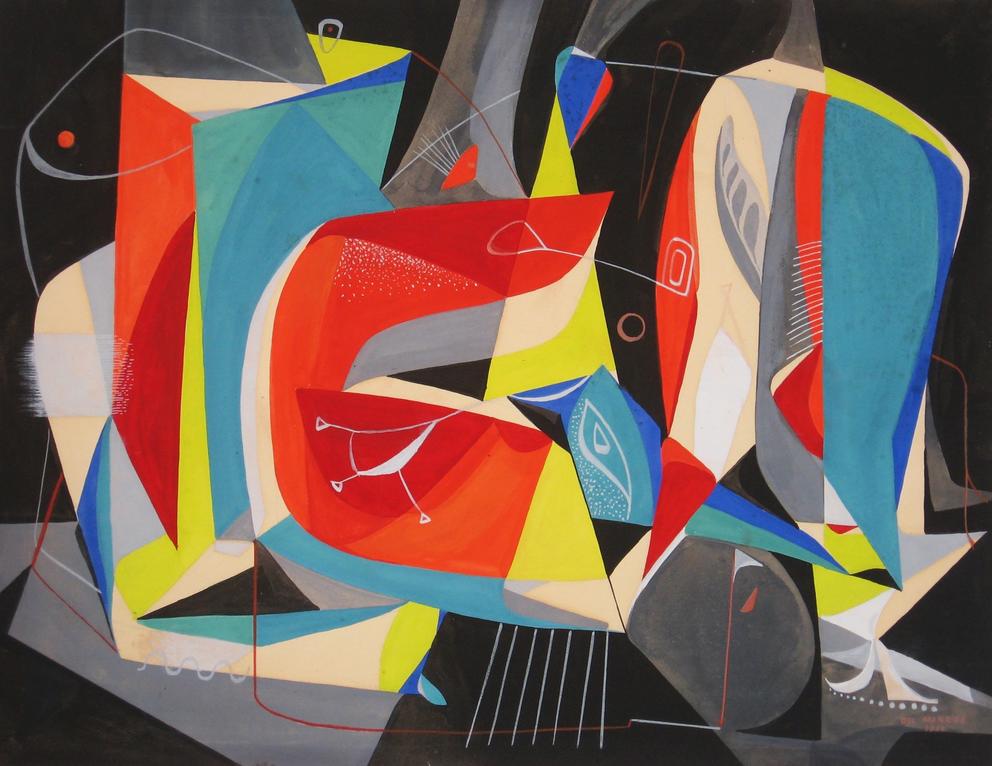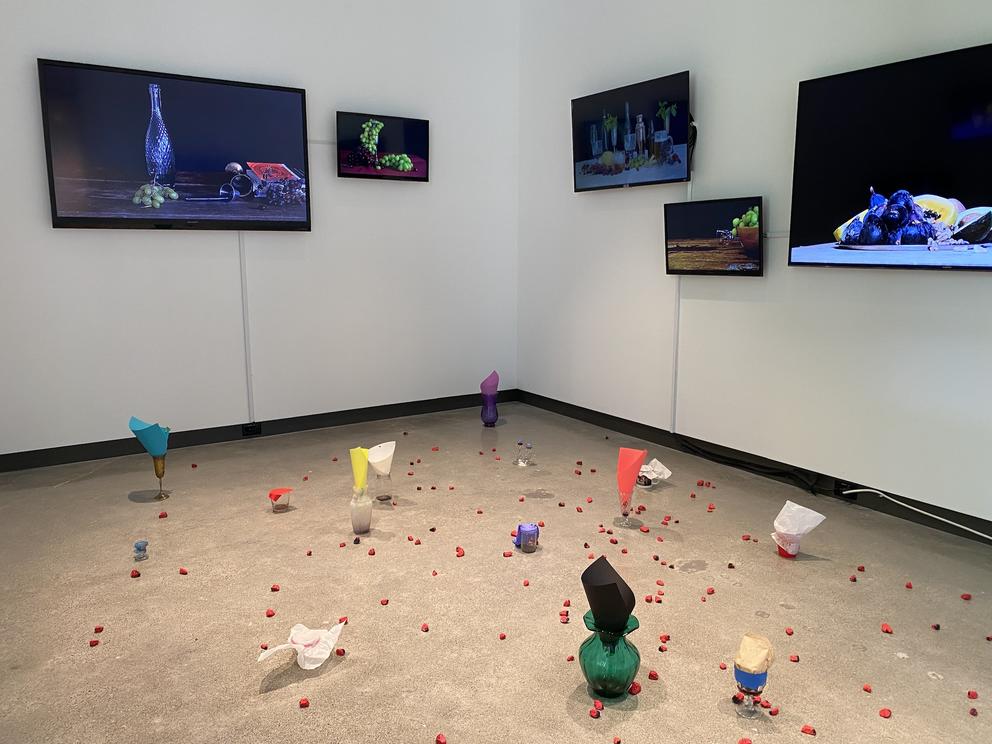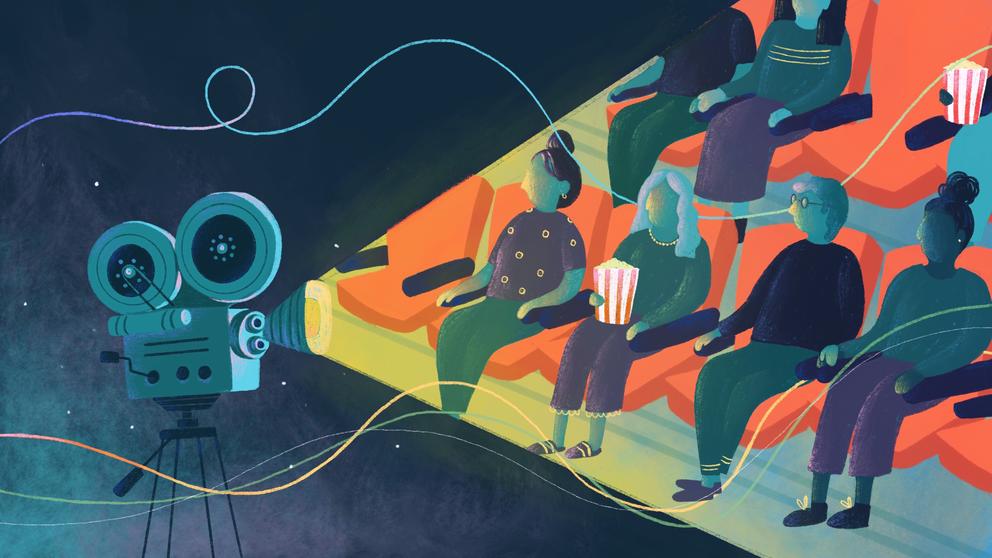But here we are in October, on the brink of Indigenous Peoples’ Day (Oct. 9), and suddenly the exhibit is perfectly timed.
Showcasing 12 contemporary Indigenous artists hailing from Alaska, Canada and Sápmi, Arctic Highways (through Nov. 26) features an enticing mix of sculpture, fiber art, video art and photography. Many of the works are based in traditional craft.
Gunvor Guttorn, a Norwegian expert in duodji (the Sámi word for handcraft), has created a human-scale web of soft woven hangers. Sonya Kelliher-Combs (Iñupiaq/Athabascan) offers rows of Credible, Small Secrets, delicate vessels made from walrus gut, reindeer rawhide and human hair that speak to the history of institutional abuse of the Indigenous Alaskan population.
And Canadian artist Meryl McMaster, of nêhiyaw (Plains Cree), British and Dutch heritage, takes us deep inside her otherworldly photographs. To create these mysterious scenes, McMaster creates sculptural garments with elaborate headpieces and stages herself in barren landscapes. These dreamlike visions draw attention to the vital relationship of humans, animals and the environment.
The show is one of several celebrating Indigenous arts this month — from Downtown’s Steinbrueck Native Gallery, which is showcasing the newest collection of the prized Cape Dorset prints, created by Inuit artists in Nunavut, Canada, to KEXP, which recently launched a new program called Sounds of Survivance, featuring global Indigenous music (Mondays, 3 - 5 a.m., and thankfully also available via the streaming archive).
See also Luminosity (Oct. 5 - Dec. 2), Stonington Gallery’s annual exhibit of Northwest Native art glass. This year the show features sculpture, vessels and jewelry by Preston Singletary, Dan Friday, Raven Skyriver, Lillian Pitt and Raya Friday (the last of whom will give a talk on Oct. 12, $20).
And at the lovely Cascadia Art Museum in Edmonds, Native American Modern: Shared Expressions in Northwest Art (through Oct. 29) highlights work by regional painters Julius “Land Elk” Twohy (Ute, 1902-1986) and Delbert J. McBride (Cowlitz/Quinault, 1920-1998). Both artists created abstract, modernist works that incorporate design motifs from their Indigenous heritage. The result is a striking mid-century style all its own.
Last week I had one of my favorite kinds of arts experiences: an unexpected encounter that surprised me and made me laugh. It happened at the new location of the University of Washington’s Jacob Lawrence Gallery, just off the Art Building courtyard.
I had gone there to see Barbara Earl Thomas’ newly installed paper-cut portrait of Lawrence — the legendary painter was her former UW art teacher. It’s a beautiful homage, especially in its now-permanent location: a glass case that also contains a photo of Lawrence and one of his vibrant works, which interplay perfectly with Thomas’ evocative piece.
As I entered the first of the gallery’s three rooms, admiring the exhibit of large, colorful abstract pieces by current UW painting teacher Sangram Majumdar, I was drawn further inside by distinct crashing sounds.
These turned out to be coming from a full-room installation by fellow UW art teacher Whitney Lynn, whose Inertia Studies consists of eight screens showing video loops of what look like different still-life studies — tables set with bouquets of flowers, an open bottle of wine, various fruits, a lit candle.
Nothing moves, except every once in a while, when a tablecloth is whisked out from under one of the settings. Whomp! The fruit goes rolling and other items spill to the ground or, impressively, stay upright.
Standing in the small room and trying to guess which table setting will be toppled next is part of the fun (a ticking metronome amps up the tension). This literal disruption of fine-art tropes is part physics experiment and part magic trick. You can catch it — and maybe a few startled laughs — in the Promotion and Tenure Exhibition, through Oct. 7.
While on campus, walk over to the Henry Art Gallery for the new installation A window to the see, a spirit star chiming in the wind of wonder (through August 25, 2024). More on this massive show by Mexican-born artist Raúl de Nieves soon!
News arrived today that the iconic CINERAMA sign has been removed from the classic movie theater’s facade downtown. Back in May, we learned, along with the good news that SIFF will be reviving the dormant space this year, the bad news that the name was not part of the property sale. The new name and exact reopening date remain under wraps for now.
Meanwhile, you can rev your moviegoing engines with the many film festivals taking place this month.
SIFF is running the third annual DocFest (SIFF Cinema Uptown, Oct. 5 - 12), featuring compelling true stories from around the globe about everything from writer Tom Wolfe to the controversial 1971 Women’s Soccer World Cup; and regionally, from a “song film” by violinist Kishi-Bashi to a portrait of Richland, Washington, residents and the long legacy of the Hanford nuclear site.
The Tasveer Film Festival (Oct. 12 - 22) is in its 18th year of showcasing films from across the South Asian diaspora. Consider: the story of Pasang Lhamu Sherpa, the first Nepali woman to summit Mt. Everest; or the story of Nalini Nadkarni, an Indian-Jewish ecologist who fell 50 feet from a tree in the Olympic Peninsula rainforest and dug deep into her family history as part of her recovery. And that’s only two of the 83 films on view!
Also coming to regional screens soon:
The 15th annual Seattle Latino Film Festival (Oct. 6 - 14); the 28th annual Seattle Queer Film Festival (Oct. 12 - 22); Bellingham’s popular Doctober Film Festival (Oct. 5 - 26); and a bit farther north, the ninth annual Orcas Island Film Festival (Oct. 11 - 15), where you can see 35 new films — if you can pull your eyes away from the beauty of the San Juan Islands.
Get the latest in local arts and culture
This weekly newsletter brings arts news and cultural events straight to your inbox.






